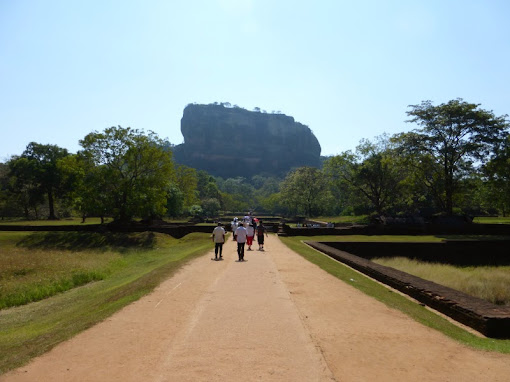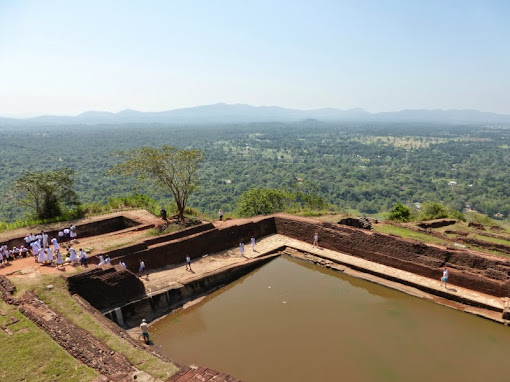Sigiriya is one of eight UNESCO World Heritage sites in Sri Lanka, and the most visited historical attraction in the country. Located in the Central Province, it is an indispensable stop along the renowned Cultural Triangle circuit. Typically, multi-day itineraries through historic Sri Lanka also include the sacred city of Kandy and the impressive ruins of Anuradhapura and Polonnaruwa.
Out of all the sites we visited within Sri Lanka, Sigiriya was the most unique, and certainly my favorite. The name means Lion Rock in Sinhalese, and it refers to a massive 660 foot-tall rock that juts out prominently in an otherwise monotonous jungle plain. During the reign of King Kasyapa (477-495 CE), the capital was moved from Anuradhapura to Sigiriya, and he initiated the construction of an elaborate palace both on the summit as well as in the immediate surroundings of the rock.
A moat and other defensive measures were established, as well as a complex system of gardens, pools, fountains, and reservoirs. Much of the surface and subsurface hydraulic networks still function to this very day, and they remain a testament to the sophisticated engineering that was required for construction.
Sigiriya moat
Gardens and fountains
Pool
The rock itself can be seen for miles in the distance. As you walk through the main western gate and pass the intricate water gardens, it becomes clear just how massive it really is. Although not nearly as large as Uluru in Australia, the prominence with respect to their surroundings is similar.
Walking towards Sigiriya
As you approach the foot of Sigiriya, massive boulders and winding paths form the boulder gardens. Some of these were hand cut and even had buildings and pavilions over and under them. After the reign of Kasyapa ended in defeat, much of the Sigiriya complex reverted back to a Buddhist monastery. A large number of the remaining ruins surrounding these boulders endure from this period.
Buddhist monastery structures
Boulder gardens
As you continue climbing up the natural hill at the base of Sigiriya, you reach the terraced gardens. Formed by multiple levels connected via limestone staircases, the terraces were created through the construction of solid brick retaining walls. The main staircase leads approximately halfway up Sigiriya, and connects with a long pathway along the side of the rock.
Terraced gardens and staircase
View of pathway along the side of Sigiriya
This is where things get really interesting. About halfway down the narrow path, authorities have constructed a spiral staircase that leads up to a hanging art gallery of sorts hundreds of feet in the air. At the height of Sigiriya's cultural zenith, perhaps thousands of frescoes were painted on the western face of the rock. Sadly, over time, much of these artifacts were destroyed or degraded by natural elements.
The few remaining 1500 year-old frescoes are in excellent condition and are simply astounding to see in person, especially considering their location and age. The identities of the nude ladies remain an unsolved mystery, but some have speculated they were the king's concubines, while others think they may have had some religious significance.
Pathway and fresco gallery above
Spiral staircase up to the frescoes
Ancient frescoes
Hanging art gallery
Back down
The view of the surrounding plains even from halfway up Sigiriya is spectacular. After descending back down the spiral staircase, you continue along the narrow pathway, but here, the mirror wall extends through the remaining length until you reach the north face of the rock.
When it was constructed, the mirror wall had a highly polished white plaster covering its interior face, such that the king could see himself whilst walking alongside it. Over the centuries, the wall lost its luster, and visitors began writing verses and poems about a variety of subjects on its surface. Writing is now strictly prohibited, of course, but examples of beautiful Sinhalese script can still be found scattered throughout the length of the wall.
View of the surrounding plains
The mirror wall, pathway, and fresco gallery above
The mirror wall along the pathway
Fortress ruins
View from the north side
The end of the pathway leads to the last terrace where the Lion Staircase is located. This was the royal entrance to the summit of Sigiriya, and in ancient days, featured an enormous statue of a lion's head above the remaining paws. The head has long since collapsed, as has the original stairs leading to the top, but a new steel staircase now carries thousands of tourists up safely. The stairs can be quite steep and narrow for two-way traffic, but it shouldn't be a problem for anyone in relatively decent shape.
Lion Staircase
Remaining lion paw
New steel staircase and remnants of ancient stairs
View below
Once at the top, I was surprised at how relatively flat the summit was. Only the foundations of the elaborate palaces remain, so there really isn't a whole lot to see. Using your imagination, however, it's easy to visualize how spectacular the grounds must have been during its heyday. The 360° view of the surrounding terrain is truly something to behold, and amazingly, there is even a massive pool built along the edge of the complex.
Palace ruins
Summit pool
Top of Sigiriya
After spending about 45 minutes at the summit, we descended all the way back down to the base of the rock via an alternate route. We toured the remaining maze-like pathways of the boulder gardens, passing the famous Cobra Hood Cave and a number of other Buddhist monastery rock shelters.
Descending from the summit
Looking back up at Sigiriya
Rock pavilion in the boulder gardens
Water channel
Rock shelters
Cobra Hood Cave
Lizard
Expect to spend approximately three hours or more exploring the entire site. While the entrance fee for foreigners is rather exorbitant compared to locals (~$30.00 vs. ~$0.40), I would say it is worth it to see perhaps the most unique historical attraction in all of Sri Lanka. If you want to avoid the blazing heat and massive crowds, get there around the 7:00 am opening time, and you will have much of Sigiriya to yourself for a couple of hours. Don't forget to bring extra water as there are no vendors inside the park.
We booked a comprehensive two-day tour of the Cultural Triangle that included one night in Sigiriya and a private car and guide. Getting to Sigiriya by car takes approximately four hours from Colombo, but this depends heavily on traffic conditions on the two-lane roads. On our way back, there was an accident involving a big rig and a bus, and our tortuous journey ended up taking more than six hours. Unfortunately, there are no direct trains or public buses from Colombo to Sigiriya.







































No comments:
Post a Comment